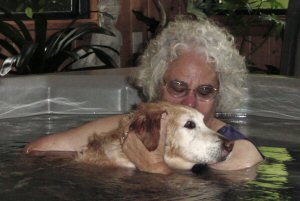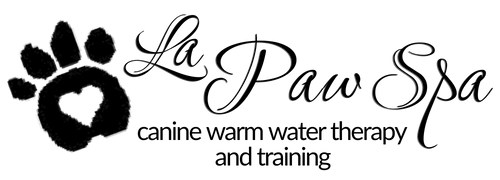by Cindy Hickman
I used to look at euthanasia as the inevitable end for my loving canine and feline companions. It was the only option that my vets offered. I always felt that either I needed to be completely onboard with all the tests, medications and procedures or else I should opt for euthanasia. After finding holistic veterinary care, I felt much more comfortable with the options I had for my senior companions. I saw the benefits that Traditional Chinese Medicine, including acupuncture and herbs, as well as good nutrition provided for my animals. This revelation occurred about the same time I discovered massage and hydrotherapy for my dogs, so the combination of all these modalities was astounding! I was amazed at how well my animals were doing. But I still felt that at some point I would have that decision to make…when to end their lives.
About a year ago, two of my clients changed my way of thinking. The first was a client who contacted me about her paralyzed dog. She said her dog no longer had any movement in her limbs and was even losing the ability to lift her head. The dog had to be fed with pureed food through a syringe. Her vets were not sure what had caused this situation, but said it was similar to ALS in people. The dog’s muscles were atrophying and the owner thought that the warm water and massage might feel good to her. Although I had no idea if I could help this dog, the love and compassion in the owner’s voice prompted me to try. When I met this dog, I could see that her spirit and personality were intact, even if her body had failed. We got in the pool together, and this dog loved it! We floated together as I massaged her and gently stretched her limbs. Over the months they came for their sessions, I got to know and respect her owner. The owner had worked in human hospice care and felt that animals should also live out their natural lives, a concept I had truly never considered for my animals. This dog lived several more months before passing away peacefully at her owner’s side.

About the same time I was working with a dog that had lost a leg due to osteosarcoma, and the owner was aware that the cancer had probably metastasized to the lungs. The dog did well for quite a while, and then suddenly took a turn for the worse. The owner decided on euthanasia and asked me to go with her as she was alone and had never experienced an animal’s euthanasia. I agreed. I won’t go into detail, but it was the most horrific experience I have ever been through. I still grieve for that dog, and feel so horrible that his owner’s last memories of him are so heart wrenching.
Soon after these experiences I heard of the SPIRITS in Transition seminar on animal hospice. I attended that first seminar in Ashland, OR and the information that Ella Bittel presented had a profound impact on me. I think the most important idea was that the option to let an animal live out their natural life is indeed a viable alternative to either full blown medical intervention or euthanasia. Ella’s teachings are based on ancient traditions, scientific knowledge, and the inherent value of the animal’s life. Dying is an important part of this life. Included in these teachings is the distinction between hospice care and geriatric care.
In our profession, we have all seen geriatric animals. They have slowed down, may have arthritis, weak hind ends, incontinence issues or other problems. They have become more fragile. During this stage, which can last quite a long time, we are still doing all we can to keep them happy and healthy. It’s the stage when alternative modalities become so important as they offer great benefit with far less side effects than conventional medicine. That stomach upset caused by an antibiotic may not be a big deal in a younger dog, but can be life threatening in a geriatric dog. There is no doubt that geriatric care can be a lot of work, but I also find it very rewarding.
The transition to hospice care, which is provided during the animal’s natural dying process, can be hard to define. Sometimes while providing hospice care, the animal may rebound and have many more happy months of life. While this is not the goal of hospice care, it certainly is a fantastic side effect! What I learned in the SPIRITS in Transition seminar has helped me understand the stages of the dying process and be more prepared to face this time with my animals. Now I know that loss of appetite in an animal at the end of its life is simply a sign the body no longer has use for nutrients coming in as it brings its processes to a closure. This is very different from “starving”, as we can learn from human hospice that there actually no longer is a sensation of hunger. There is also comfort in the fact that dehydration, as may occur in the last stages of dying, can decrease sensitivity for pain so much that if pain medication was used before it may no longer be needed.
I feel confident that in the future I can make decisions based on knowledge and listening for what my companion wants, rather than fear and avoidance. While my vet is giving their professional opinion, I know that all decisions are ultimately mine and I want to be the voice for my animal companion during this sacred time. I am also able to discuss hospice care with my clients, and I encourage them to really tune in to their animals and trust that they know their companion better than anyone else.
I believe we can learn a great deal from the way that animals deal with life and death. A geriatric animal that can no longer participate in activities that he once found enjoyable doesn’t sit around and mope about his lost youth or worry about his future, he lives in the moment. He doesn’t look at a quality of life scale and decide it’s time to check out if he doesn’t reach an acceptable number. If I would have used the quality of life scale for my senior Dalmatian, Susanne, last winter, I would have concluded that it was time to euthanize her. Thankfully, we kept going and this year she is doing great! Yes, we know our animal companion is going to die eventually, but what a gift to our animals and ourselves if we can embrace that process and not try to make it fit into our own timelines and hurried lifestyles. We may have to slow down and spend more time at home, not such a bad idea, or ask friends for help. Isn’t our companion worth it?
•
Cindy Hickman is the owner of Aquadog Spa and is a Licensed Massage Practitioner, Nationally Certified in Therapeutic Massage and Bodywork, and endorsed as a Small Animal Massage Practitioner.
A note from Cindy Horsfall: I was so moved by this story that Cindy Hickman and I will be hosting the Spirits in Transition Seminar this May. Please see our calendar of events for more details
•
May I be at peace
- May I have an open heart
- May I know the beauty of my true nature
- May I be healed
- May my life be a gift of peace in the world
